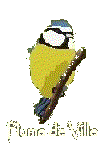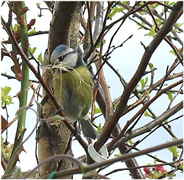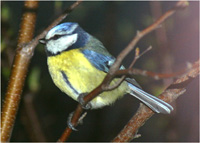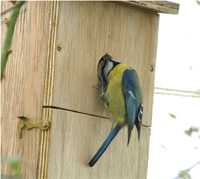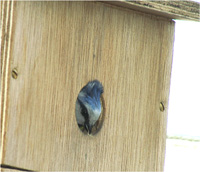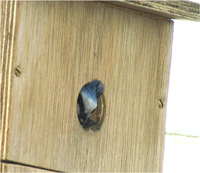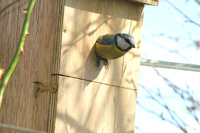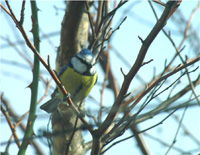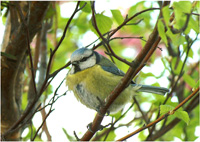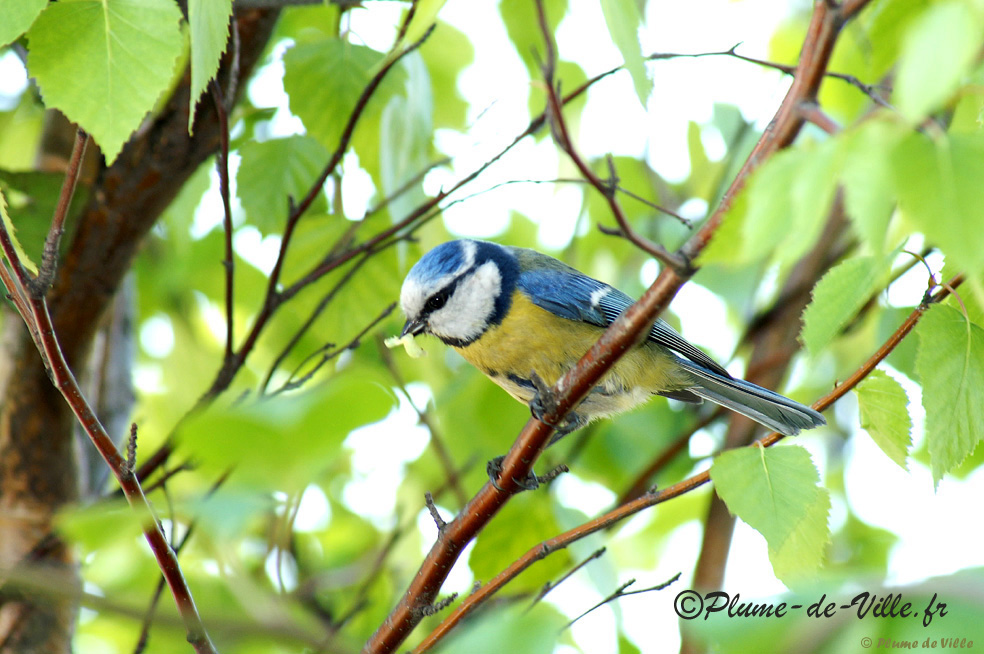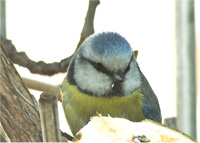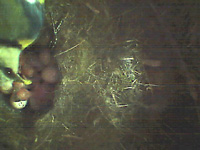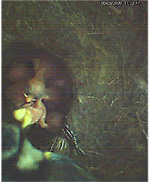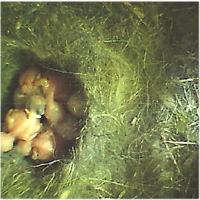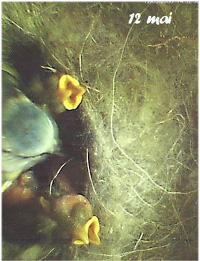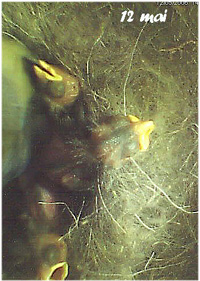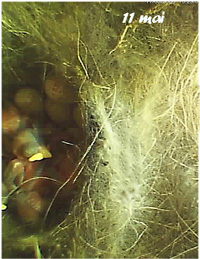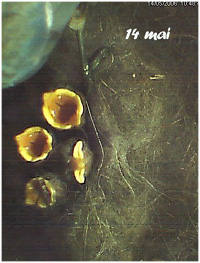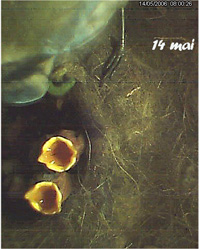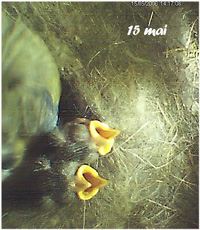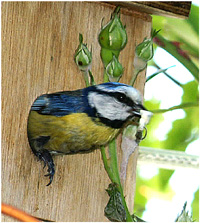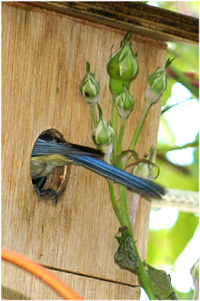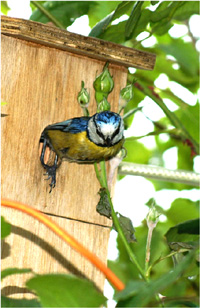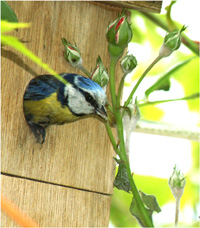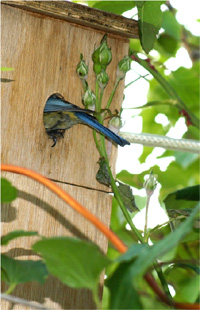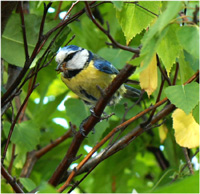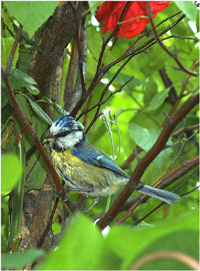Plume de Ville
Nesting 2006:

 Since
the 16 February the nesting started. The weather is cold: 0°
C in the morning. The first green moss strands were brought. The female
tit which prepares the nest alone. The male, enters the nest
after a small dance, tail raised and wings lowered,
but
does not seem to be tolerated any more in the nest. He comes
out
as quickly as he is went in, as if he had firmly been requested to
leave at once. Then he encourages her, and sings perched in his birch,
beside the nest. Also, now and then, he brings her some
offerings.
Since
the 16 February the nesting started. The weather is cold: 0°
C in the morning. The first green moss strands were brought. The female
tit which prepares the nest alone. The male, enters the nest
after a small dance, tail raised and wings lowered,
but
does not seem to be tolerated any more in the nest. He comes
out
as quickly as he is went in, as if he had firmly been requested to
leave at once. Then he encourages her, and sings perched in his birch,
beside the nest. Also, now and then, he brings her some
offerings.
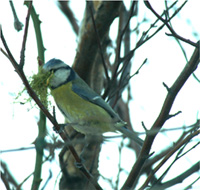
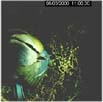 Sometimes,
the billfuls of moss, too large, have difficulties to pass trough the
door and remain partly hung at the entry of the nest. After a first
good layer of moss, a layer of straw and dry grass completes the nest.
Sometimes,
the billfuls of moss, too large, have difficulties to pass trough the
door and remain partly hung at the entry of the nest. After a first
good layer of moss, a layer of straw and dry grass completes the nest.
end of March
Finally, in the last week of March she adds, cotton, filaments
and feathers, for a quite soft layer. 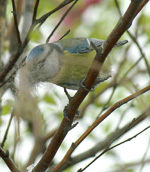
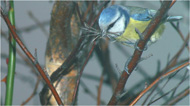
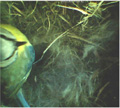
All the materials are tested. Our hairy candle cactus
was mowed and is now in the nest.
At the end of March, weather is very cold. Frost in the nights. In the afternoons temperature attains only 2-3° C.
Works are in progress in all the nests. A “moinette” mows our asparagus with application. And sets out again with large mouthfuls of leaflets, a little prickly perhaps, but each to his own!
1 April
Since the 1st April, she comes to sleep in the nest every
evening, at dusk.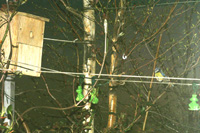
He awaits her very early in the morning, it is still night at 7h when he arrives and he will sing on the birch until she decides to rise. Sometimes she delays, sleeps on, he gets impatient! Probably all the neighbors are awakened before her by his teet, teet, teeeeet.
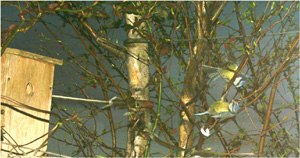
At last, she comes!

He comes and perch close to her, with the cap lifted, the wings
shaking, half-opened and lowered, the tail lifted.
During of the day, she continues to adapt the nest to her taste and not
only the interior.
She would like to enlarge the entry hole!
What does she want?
Her blue cap is ruffled at the entry hole.
Before taking a small rest in the sun.
The nest seems almost
finished. She still adds there some beautiful feathers, she
does not
resist.
10 April: Today she went to bed much earlier than the other days, while
there was still light.
11 April

 This
morning, one egg!
This
morning, one egg!
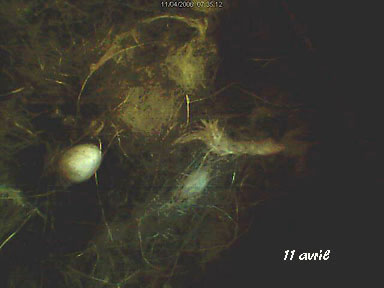
She now will lay an egg the every day. She covers and hides her eggs in the morning, and the both tits spend the day outside. She passes from time to time in the course of the day, but does not brood permanently.
Of course, she returns every evening.
We will have to wait until the 18-19
April, the 7th egg, for her to spend
much more time in the nest. Weather is better, beautiful sun and
16°C. She
leaves much later in the morning. He always sing, but disappears during
long periods in the course of the day.
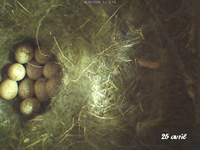
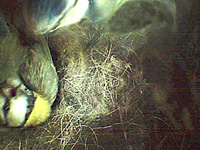
20
April: 8 white eggs, stained with brown red, arranged
well.
Now she broods,
and she will brood alone. He comes to nourish her. He calls from
outside
and she answers by small "pips". Small quiverings of wings and tail
raised for both, like future chicks when they beg their caterpillars.
Then he enters the nest. She has the bill largely opened to receive
the caterpillar. He does not remain and immediately sets out again to
seek another billful. Weather is hotter (22°C).
22,
23, 24 avril: 9
eggs. 22°C. She leaves in the morning a short moment but
quickly
returns to
brood. She arises in the evening around 17h to nourish herself, and
returns towards 20h before the night.
25 April
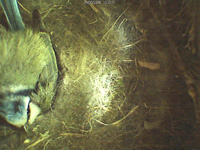
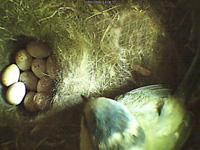
10 beautiful eggs well arranged !
She broods.
26 April: common swifts arrived at Paris.
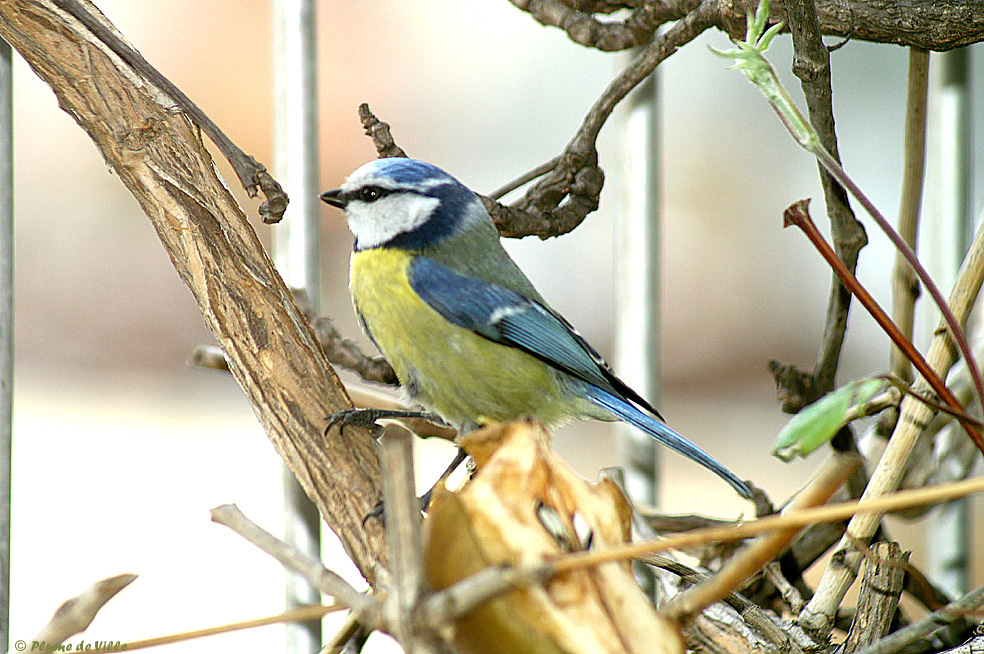
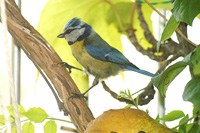
And she like he, for their splendid blue, fully deserve to
be called "Parus caeruleus" (or Cyanistes caeruleus).
He, nourishes her. When he arrives he utter small chirps to call her, she answers and sometimes leaves to join him. Sometimes happens that he seeks her, while she is not in the nest. Then he enters the head, then a little more of the head, he remains at the entry, he hangs around… seems astonished. He concludes that he does not see well and enters the nest with its caterpillar. Definitely she is not there! Lastly, a small cry (like a little that of the swallows) but outside! Phew! He will not be obliged to eat its beautiful caterpillar.
6 May: Beautiful sun, finally hot (25°).
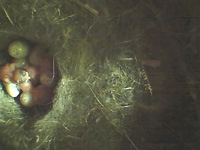
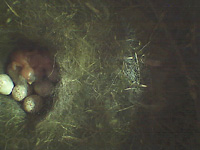 7 May
7 May
 This morning, 7h
the first chick!
This morning, 7h
the first chick!
Temperature is 15°C and the weather is overcast.
8h15 here is the second.
He works. He enters with a caterpillar, which she takes to distribute among the chicks.
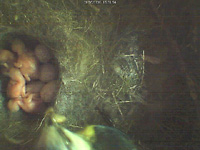
She distributes the caterpillars brought by him, to the two chicks.
If she is not there, he takes care of the
distribution. He remains with precaution on the edge of the nest to
give the beakful.
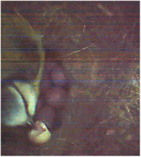 9h 20 birth of the third chick. She
assists it. Then, on several
occasions we see her with a half eggshell, she eats the shells, because
none
remains in the nest and she needs to recover all
the
calcium of 10 eggs!
9h 20 birth of the third chick. She
assists it. Then, on several
occasions we see her with a half eggshell, she eats the shells, because
none
remains in the nest and she needs to recover all
the
calcium of 10 eggs!
When
he arrives, it is always with a yellow green caterpillar,
that she
divides. Sometimes she eats one of them. The small chicks have a large
head which they do not yet manage to raise. With enormous
globular eyes
still closed and down feathers around the eyes. Large yellow bills to
receive the piece of caterpillar. They do not have yet the reflex
to open the bill and she must move the billful over the small chicks to
invite them to open the bill. They will learn quickly, in
two days they will open the bill at the arrival of one of the
parents. Sometimes the billful is… a little large!
Rainy night, overcast, 15°C. The fourth is born this morning. A brood of 4 chicks all naked, all pinks. The brood is complete, the 6 other eggs will not hatch, perhaps because of the bad climatic conditions.
9-18 May
11 May: The chicks grow very quickly. Their bills have
enormous yellow moustaches.
12 May: Sun 22°. They do not see yet but are increasingly active. Four days and we begin to guess the quill of the feathers, in particular on the wings. She remains less in the nest and the supplying is made by both parents.
14 May: Beautiful caterpillar, for four
yellow pits with their small orange
points. The quill of the feathers grows and they are not more
pink but dark now. They have 7 days. A chick starts already,
to
half-open
the eyes, especially with such a beautiful insect!
15
May: Up to now the chicks were nourished with
beautiful green, tender and fleshy
caterpillars. Now the mode changes. In addition to the green
caterpillars, more and more insects are supplied to supplement the
meal.
The eyes are half-opened.
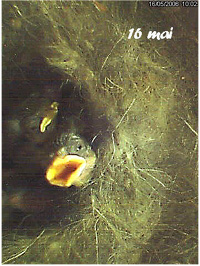
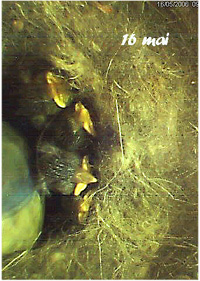
16 May: More and more of feathers, the quills open,
they start to flap the wings, one of them tries to go up on the edge of
the
nest.
17
- 18 May: They grow bigger! Four beautiful
“chickens”, which leave more and more
the bowl of the nest and flap their wings. Their eyes are
quite
open.
As for the parents, there is the household...
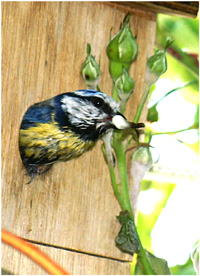 To defecate chicks raise their bottoms.
A small
white bag comes out, the fecal bag, which she take and carry
to throw it far
outside
avoiding all traces for the predators. Even soaked like this day!
To defecate chicks raise their bottoms.
A small
white bag comes out, the fecal bag, which she take and carry
to throw it far
outside
avoiding all traces for the predators. Even soaked like this day!
And, four great bills to be nourished...
Many journeys in and out are needed!
And some acrobatics...
To bring back the menu... insects, caterpillar
At the beginning the menu of youngsters is exclusively made up
of large
quite fatty green caterpillars. Then, coleoptera, insect larvae,
flies and aphids supplement the menu.
Lastly, well later, some shelled seeds of sunflower and catkin seeds of birch, willow or poplar which abound at this period of the year.
The chicks, beakful after beakful, will become
Mésanges…

